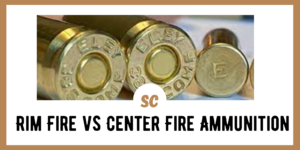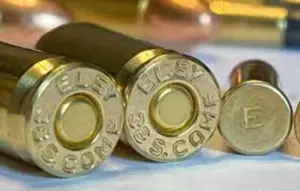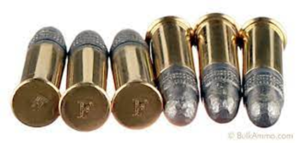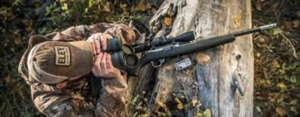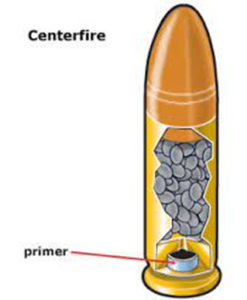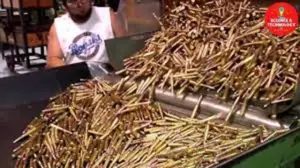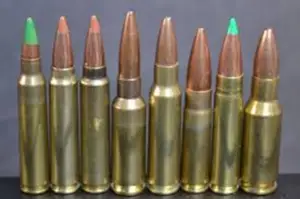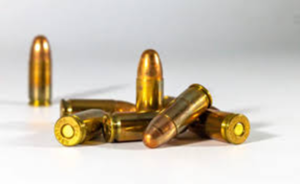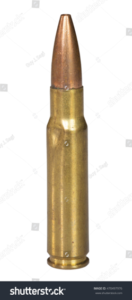Two terms get used frequently among shooters: rimfire and centerfire. Rimfire and centerfire ammunition are the two flavors of cartridges with which we work on a daily basis. Most shooters never give the terms a second thought until someone asks them to describe the difference between rimfire ammunition and centerfire ammunition.
Rimfire ammunition has the primer compound crimped into a rolled edge at the bottom of the cartridge walls. Centerfire ammunition uses a removable and replaceable primer button in the center of the cartridge base. Centerfire cartridges can be reloaded and reused, unlike rimfire cartridges.
There is really no debate about which is better when comparing rimfire and centerfire ammunition. Each has its advantages, disadvantages, and its proper place. Learning the difference between rimfire ammunition and centerfire ammunition makes it much easier to understand the best place for each type.
Rimfire Ammunition
If you are like me, your earliest hunting and shooting memories involved some sort of .22 caliber rimfire gun. Mine was a Ted Williams single-shot .22 caliber bolt action gun. I had to manually cock the hammer after inserting a single round of .22 ammunition into the chamber.
I didn’t learn until much later about the difference between rimfire ammunition and centerfire ammunition. Unfortunately, many shooters today are still unaware of the real differences between these two types of ammunition.
The Name Tells the Tale
Rimfire cartridges speak for themselves with the name. The main defining characteristic of rimfire cartridges is the location of the priming compound. A rimfire cartridge case has a small cavity around the circumference of the cartridge base. The priming compound is put into this cavity as the ammo is manufactured. A rimfire rifle firing pin strikes the rim of the cartridge to ignite the primer and send the round on its way.
Other Differences Of Note
Since its introduction in 1857 by Smith and Wesson, rimfire ammo has enjoyed wide use and has seen several innovations in both calibers and the technology behind the rimfire rounds. Today, the most popular sizes of rimfire ammunition are the .22 caliber and the .17 caliber. Rimfire does have some distinct differences from centerfire ammunition.
Manufacturing Methods
Rimfire ammunition is relatively cheap and easy to manufacture. In general, the rimfire cartridge cases are drawn from a sheet of thin brass plate and formed with a hollow ring at the base. Some manufacturers place the primer compound on the brass before forming the cartridge. Others force the priming compound into the hollow space after the cartridge is formed.
This process has some inherent limitations. The case walls of rimfire cartridges must remain thin enough for the forming process. This limits the pressures that rimfire rounds can sustain. Lower pressures mean less velocity and energy downrange.
Calibers and Bullet Weights
Historically, many different and relatively large bullets have been loaded as rimfire ammunition. However, with the transition to smokeless powder and the higher pressures involved, most ammunition and rifle manufacturers quit making larger calibers in rimfire configurations.
Today, the two most popular rimfire configurations are .22 and .17. There are several different types of each cartridges from which to choose, including:
- .22 short
- .22 long
- .22 long rifle
- .22 Winchester magnum rimfire
- .17 Hornady Mach 2 (.17 HM2)
- .17 Hornady Magnum Rimfire (.17 HMR)
- .17 PMC/Aguila
- .17 Winchester Super Magnum
There are other calibers available in a rimfire cartridge, but their use is limited, and the ammunition can be hard to find.
Ballistic Characteristics
In general, rimfire ammunition is considered low-power and low-velocity ammunition. Part of this stems from the requirements to keep pressures lower. The small size of the most popular rimfire ammo also contributes to the ballistic characteristics of this ammunition.
A typical .22 caliber long rifle cartridge shooting a 40 gr bullet develops muzzle velocities in the 1,200 to 1,300 feet per second range. The average energy at the muzzle of these cartridges is 135-foot pounds.
Compare this to a centerfire cartridge chambered for the .223 Remington and shooting a .55 grain bullet. The .223 Remington develops muzzle velocities in the 3,000 feet per second range. The energy at the muzzle of these .223 Remington rounds is in the neighborhood of 1250 foot-pounds at the muzzle.
Where Rimfire Excels
There are places where rimfire ammunition is a perfect choice. These uses keep rimfire rifles popular among shooters across the country. In fact, the popularity of rimfire rifles and ammunition continues to grow.
Training New Shooters
Many instructors and veteran shooters use rimfire rifles and pistols as training tools for new shooters. The low cost of the ammunition is one factor. Little or no recoil is another factor, making the .22 rimfire a great choice for introducing new shooters to the sport.
Plinking and Target Shooting
There is nothing more fun than spending an afternoon plinking and target shooting with a .22 rimfire rifle. The relatively low cost of the ammunition is the main advantage. Many shooters never go further than rimfire for their shooting activities.
Hunting
While rimfire ammunition is relatively slow and doesn’t pack much power, on small game and varmints, it can be a potent round to shoot. Rabbits, squirrels, and other rodent-sized game animals are routinely hunted with rimfire cartridges and rifles.
Competition Shooting
Rimfire competition shooting is more popular than ever. Athletes around the world compete in a wide variety of shooting sports that use the .22 caliber round. From the Olympics to your neighborhood shooting club, rimfire competitions are a popular way to spend a Saturday afternoon for all ages.
Comfort
Shooter comfort is a big reason that rimfire is a popular choice. Rimfire rifles typically have little or no recoil, making them comfortable to shoot. These guns and the ammunition are usually lighter than centerfire options, which is another factor in comfort.
Centerfire Ammunition
Most hunters are quite familiar with centerfire ammunition. Centerfire cartridges make up the bulk of ammunition sold for hunting purposes. On the whole, centerfire cartridges are more powerful than rimfire ammo. Centerfire ammo has advantages over rimfire ammo that every shooter should understand.
Centerfire ammunition differs from rimfire ammo in the way it is manufactured and its ballistic characteristics. Centerfire ammo is more powerful, usually larger, and more dependable than rimfire cartridges.
Examining The Cartridge Gives the Clues
A cursory glance at a centerfire cartridge quickly makes clear the major difference from rimfire loads. Looking at the base of the cartridge, the primer button is evident. On centerfire ammunition, instead of the primer compound being set into the cartridge rim, a pocket is built into the base of the cartridge for a primer button.
There are several reasons that the centerfire cartridge design features this primer button. Understanding the reasons for this difference and how it affects the ballistics of the centerfire cartridge gives you a better perspective on choosing between centerfire and rimfire ammo.
Why Centerfire Over Rimfire
Centerfire ammo has many advantages that make it more popular for hunting than rimfire cartridges. Centerfire ammo also has some disadvantages that must be noted when making cartridge and caliber choices:
Manufacturing Centerfire Ammo
Centerfire ammunition is more expensive to manufacture than rimfire ammo. Manufacturing a typical centerfire brass cartridge involves drawing and forming the case from a brass sheet using multiple steps. Various dies are employed to bring the brass to its final shape, ready for loading and eventual sale.
Because of the pressures involved in shooting a centerfire round, the manufacturing process is critical to ensure that case wall thicknesses are uniform and adequate. In addition, extra steps are required to place a primer button in the primer pocket on the new case before adding gunpowder and other components.
These extra steps and critical quality controls requirements add to the manufacturing costs involved. However, the die forming process allows much larger calibers to be produced in a wide variety of powder loads and bullet types.
The Case for Reloading
One great feature of centerfire cartridges is the ability to reuse and reload spent cartridges. Shooters have been reloading their own ammunition for years. Some of the most popular pistol and rifle centerfire cartridges on the market today were originally developed by shooters experimenting on their own.
The primer button on most centerfire cartridges can be easily removed and replaced with a fresh, unspent primer. There are other steps to be performed in this process, but it is the primer button that is the key to making reloading possible.
Ballistics, Hunting, and Competitive Shooting
Centerfire cartridges typically are much larger than rimfire cartridges. The larger size allows larger powder loads and heavier bullets to be loaded. It should be evident that a typical .22 or .17 caliber rimfire cartridge is not adequate for game larger than a small rodent. The small powder loads also limit the distances at which a .22 or .17 caliber is effective when loaded in a rimfire case.
Centerfire rounds are available from .17 to .50. This offers hunters the capability of effectively and humanely hunting any game animal in the United States including bison, grizzly bears, or moose. Big game hunting is the number one focus of large caliber hunters.
Competitive shooters are not forgotten. Combined with the right rifle, a centerfire cartridge can be effective at ranges of 1,000 yards or longer. Hunters may make use of this range capability as well. Accuracy with centerfire ammunition is also considered much better than rimfire ammo.
Reliability – An Issue for Some Shooters
From a reliability standpoint, centerfire ammo gets the advantage. The manufacturing process for rimfire ammo often leads to failures to fire. Centerfire ammunition is much more reliable. It is this reliability that makes centerfire ammo the choice for military and law enforcement ammunition.
Reliability is critical, especially in self-defense situations. If you depend on your gun for self-defense, you must be sure it will fire at every pull of the trigger.
Shooter Choice and Options
The wide array of different styles and sizes of loads is astounding. No matter what type of shooting or hunting you plan, there is a caliber and style of a bullet to fit your needs. The number of choices can make selecting a caliber and bullet confusing. Taking the time to understand your needs and expectations before making this decision is critical to your success and your enjoyment.
Which is Better – Rimfire or Centerfire
In my opinion, it isn’t a matter of which is better. The question should be which is more appropriate for the type of shooting you plan. Each type of ammunition offers distinct advantages and disadvantages that make each type of cartridge excel at different types of shooting.
The Advantages of Rimfire or Centerfire
A quick look at the advantages and disadvantages of both types of ammo is handy when you are trying to decide which type of ammo to use. Of course, your expectations and preferences are the key factors in any ammunition choice.
Rimfire Ammunition – Advantages
- Rimfire ammunition is typically cheaper than centerfire rounds, making your shooting more cost-effective.
- Less recoil from rimfire ammunition makes these cartridges great training tools.
- The lighter weight is an advantage when transporting and storing rimfire ammo.
- Excellent for rodent or small varmint control at short ranges.
Rimfire Ammunition – Disadvantages
- Relative short effective range due to cartridge powder loads and pressure limitations.
- Low muzzle velocities and low delivered energy limit the size of the game you can effectively and humanely hunt.
- There may be reliability issues with rimfire rounds.
Centerfire Ammunition – Advantages
- Centerfire ammo typically delivers higher muzzle velocities and greater delivered energy than rimfire ammo.
- Commercial centerfire cartridges offer better reliability.
- A wider range of calibers, loads, and bullet styles is available for centerfire rifles.
- Centerfire cases can be reloaded, which saves money and allows customization of your ammo loads.
Centerfire Ammunition – Disadvantages
- Centerfire rounds are typically more expensive than rimfire rounds.
- There is a significant weight difference between centerfire and rimfire that can be an issue for some shooters.
- The rifles designed to shoot larger centerfire rounds are more expensive than rimfire rifles.
Making the Choice – Centerfire and Rimfire Ammunition
The overlap between centerfire and rimfire is not that great. It doesn’t matter if you are shooting a centerfire handgun or a rimfire rifle, the choice is often determined by the results you want. Both types of ammunition offer advantages and disadvantages that differentiate where they excel. The answer is not which is better, but which type of cartridge is more appropriate.


